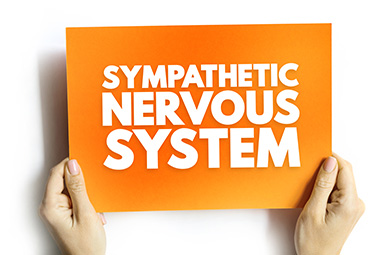The Sympathetic Nervous System: How Stress Fuels Muscle Tension and Pain

When we think of pain, most of us imagine injuries, strains, or inflammation. But there's another player that's lurking behind the scenes: the sympathetic nervous system (SNS). This is your "fight-or-flight" system, it's part of your autonomic nervous system (ANS), which regulates functions outside of your conscious control such as heart rate, blood pressure, and digestion.
While the SNS is crucial for survival, it can also be a hidden culprit in chronic muscle tension and pain.
Meet Your Body's Stress Switch: The Sympathetic Nervous System
The sympathetic nervous system kicks in when your brain perceives a threat. Imagine you're about to give a big presentation, take part in a competition or you hear a sudden loud noise, your SNS instantly activates.
Your physiology changes...
- Your heart rate and blood pressure spike, pumping oxygen to your muscles.
- Adrenaline and cortisol flood your system to sharpen focus and energy.
- Your muscles tighten, preparing you to run or fight. (Hence "fight or flight").
This reaction is incredibly useful if you're escaping danger. But in modern life, many "threats" aren't life-or-death, they're deadlines, bills, bad relationships or constant notifications.
What Happens When the SNS Doesn't Switch Off
The problem arises when the SNS stays activated for too long. Instead of cycling back into a relaxed, restorative state (managed by the parasympathetic nervous system), your body remains in a subtle fight-or-flight mode.
The consequences?
- Chronic muscle tension: Muscles stay partially contracted, especially in the shoulders, neck, and jaw.
- Circulation changes: Reduced blood flow to tight muscles means less oxygen and nutrient delivery, making them more prone to fatigue and pain.
- Nervous system sensitization: A hyper-alert nervous system can amplify pain signals, making even mild discomfort feel intense.
Muscle Tension and Pain: The Hidden Loop
Here's the tricky part: muscle tension itself can cause pain, and pain can reinforce the stress response, creating a vicious cycle.
- Stress triggers SNS activation which causes muscles tighten.
- Tight muscles restrict circulation which can trigger soreness or pain. The inability of lactate and hydrogen ions the byproduct of muscular contraction gets stuck within the muscle leading to increased sensitivity and pain.
- Pain signals feed back into the nervous system which means the body perceives more threat. This leads to reduced movement and muscular guarding.
- SNS ramps up again and muscles tighten even more.
Over time, this loop can contribute to conditions like tension headaches, TMJ pain, back stiffness, and even fibromyalgia flare-ups.
Finding Balance: Calming the Sympathetic Nervous System
Breaking this cycle means giving your parasympathetic nervous system—the "rest-and-digest" system—a chance to step in. Practices that help include:
- Deep breathing: Signals safety to the body, lowering SNS activity.
- Progressive muscle relaxation: Teaches muscles the difference between tension and release.
- Mindfulness or meditation: Reduces stress reactivity.
- Gentle movement (yoga, tai chi, walking): Improves circulation and helps muscles relax.
- Good sleep: Rest resets the balance between sympathetic and parasympathetic activity.
What to take from this?
The sympathetic nervous system isn't "bad", it's designed to keep us safe. But when modern stress keeps it switched on, the result can be chronic muscle tension and persistent pain. By learning to calm the SNS and engage the body's natural relaxation systems, we can reduce tension, ease pain, and restore balance. This is why a holistic approach and lifestyle changes are essential to optimise your journey to reduce your pain alongside therapeutic treatments and rehabilitation programs. It's also proof that more pain isn't more gain, if your sports massages are hurting you beyond "comfortably uncomfortable" then they might be doing more harm than good!
If you suffer with any chronic pain, feel free to get in touch so I can point you in the right direction to getting pain free.
I hope this helps!

